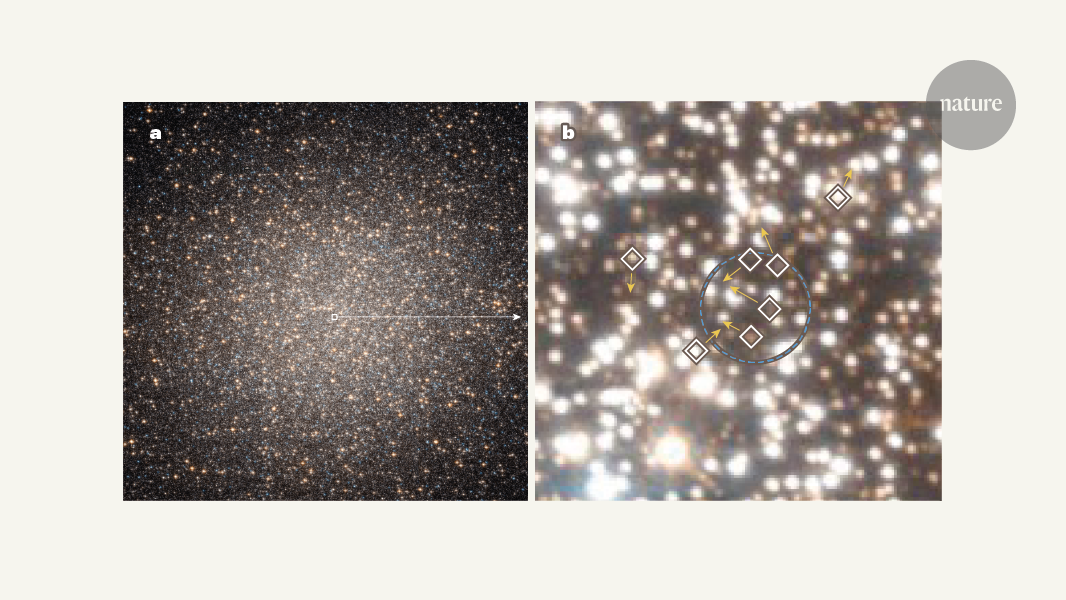Discovery of Fast-Moving Stars Suggests Presence of Intermediate-Mass Black Hole in Milky Way Globular Cluster
Główne pojęcia
The discovery of unusually fast-moving stars in the Milky Way globular cluster ω Centauri provides evidence for the potential presence of an intermediate-mass black hole at its center.
Streszczenie
The article discusses the ongoing search for intermediate-mass black holes, which are believed to be essential building blocks for the supermassive black holes found at the centers of galaxies. While a few candidates have been identified, a significant gap remains in this mass range.
The key highlights from the article are:
- Intermediate-mass black holes, with masses between 100 and 100,000 times the mass of the Sun, are one of the most elusive members of the astrophysical object class.
- Evidence is mounting that the mergers of pairs of black holes, such as those detected through gravitational waves, could produce intermediate-mass black holes, particularly in dense stellar environments.
- Häberle et al. report the discovery of unusually fast-moving stars in the Milky Way globular cluster ω Centauri, which offers evidence that an intermediate-mass black hole might be present at the center of this cluster.
- The discovery of these fast-moving stars provides a potential new avenue for identifying intermediate-mass black holes, which have been difficult to detect using other methods.
Customize Summary
Rewrite with AI
Generate Citations
Translate Source
To Another Language
Generate MindMap
from source content
Visit Source
www.nature.com
Speedy stars blow the cover of hidden black hole
Statystyki
Intermediate-mass black holes have masses between 100 and 100,000 times the mass of the Sun.
The Milky Way globular cluster ω Centauri is the focus of the study.
Cytaty
"Intermediate-mass black holes remain one of the most elusive members of an already exotic class of astrophysical objects."
"Evidence is also mounting that the mergers of pairs of black holes, such as those detected through gravitational waves, could produce intermediate-mass black holes, particularly in dense stellar environments."
Kluczowe wnioski z
by Daryl Haggar... o www.nature.com 07-10-2024
https://www.nature.com/articles/d41586-024-02135-9
Głębsze pytania
What other observational techniques or indirect evidence could be used to further investigate the potential presence of an intermediate-mass black hole in ω Centauri?
To further investigate the potential presence of an intermediate-mass black hole in ω Centauri, astronomers could employ various observational techniques and indirect evidence. One approach could involve studying the dynamics of stars within the globular cluster ω Centauri. By analyzing the velocities and trajectories of stars near the cluster's center, researchers can look for signs of gravitational interactions that may indicate the presence of a massive object like an intermediate-mass black hole. Additionally, astronomers could search for X-ray emissions or radio waves coming from the center of the cluster, which could be produced by the accretion of material onto the black hole. Another method involves studying the distribution of dark matter within the cluster, as the gravitational effects of an intermediate-mass black hole would influence the overall mass distribution in ω Centauri.
How might the formation and evolution of intermediate-mass black holes differ from their smaller and larger counterparts, and what implications could this have for our understanding of black hole formation and growth?
The formation and evolution of intermediate-mass black holes (IMBHs) differ from their smaller stellar-mass black hole counterparts and larger supermassive black holes in several ways. IMBHs are thought to form through the direct collapse of massive stars or the merger of smaller black holes in dense stellar environments. Unlike stellar-mass black holes, which result from the supernova explosions of massive stars, IMBHs occupy a mass range that bridges the gap between stellar-mass and supermassive black holes. This intermediate mass range suggests that IMBHs may play a crucial role in the hierarchical growth of black holes in the universe, serving as seeds for the formation of supermassive black holes at the centers of galaxies.
The implications of understanding the formation and evolution of IMBHs are significant for our overall understanding of black hole growth. By studying the properties and behaviors of IMBHs, astronomers can gain insights into the mechanisms that drive black hole formation and growth across different mass scales. This knowledge is essential for unraveling the mysteries of galaxy evolution, as supermassive black holes are intimately linked to the evolution of galaxies. Understanding the role of IMBHs as intermediate building blocks in this process can provide valuable clues about the cosmic processes that shape the universe on both small and large scales.
Given the potential importance of intermediate-mass black holes as building blocks for supermassive black holes, what other galactic environments or stellar systems might be promising targets for future searches?
In the quest to uncover more intermediate-mass black holes (IMBHs) and understand their role as building blocks for supermassive black holes, astronomers can target various galactic environments and stellar systems. Dense star clusters, such as globular clusters like ω Centauri, are promising targets for future searches due to their high stellar densities and potential for black hole formation through stellar interactions and mergers. Additionally, galactic nuclei, particularly in dwarf galaxies or low-mass galaxies, could harbor IMBHs that have yet to be discovered. The centers of active galactic nuclei (AGNs) and starburst galaxies, where intense star formation and accretion processes occur, are also intriguing locations to search for IMBHs that may be actively growing through accretion of material.
Furthermore, researchers could investigate the outskirts of galaxies, where interactions between galaxies or tidal forces can trigger the formation of IMBHs. Satellite galaxies or dwarf galaxies that orbit larger galaxies are potential sites for IMBHs that have been ejected from their parent galaxies during galactic interactions. By expanding the search to a diverse range of galactic environments and stellar systems, astronomers can uncover more IMBHs and gain a deeper understanding of their formation, evolution, and role in the cosmic hierarchy of black holes.
0
